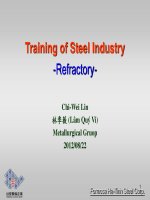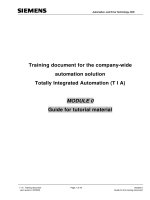Training material cement process (NXPowerLite)
Bạn đang xem bản rút gọn của tài liệu. Xem và tải ngay bản đầy đủ của tài liệu tại đây (2.31 MB, 81 trang )
ISO Team Training
04-Sept-2007
CEMENT PROCESS
CONTENT
1. Hon Chong flow chart
2. Raw material preparation
3. Raw meal preparation
4. Clinker producing
5. Cement grinding
6. Co-processing
Hon Chong Flow chart
3
HVL
ISO Team Training - Manufacturing
Cement Process ppt
Cement Production Diagram
Production of Cement by the Dry Process
Feed Bins
Sampling Station
Quarry
Raw Materials Storage
Crushing Plant (s)
Corrective Materials
and Preblending
Electrostatic
Precipitator
Homogenizing and
Storage Silo
Cooler Dedusting
Coal
Raw Meal
W ater
Air-to-Air
Cooler
Coal
Mill
Cyclone
Preheater
Rotary Kiln
Clinker Cooler
Conditioning
Tower
Raw Mill
Filter
Mineral
Gypsum Components
Bulk Dispatch
Cement
Silo
Clinker
Storage
Packing Machine
Bag Palletisation
Cement
Silo
Cement Mill
Zement-trocken-englisch.dsf
Kma 27.4.98
4
HVL
ISO Team Training - Manufacturing
Cement Process ppt
Cement Production Process _ Steps
Mining of limestone
drilling or blasting
crushing of limestone
pre homogenization
grinding of raw material
homogenization of raw meal
pyroprocessing
coal grinding, co-processing
cement grinding
Raw material extraction
Raw material preparation
Raw meal preparation
Clinker production
cement storage, packing, and dispatching
5
HVL
ISO Team Training - Manufacturing
Cement Process ppt
Raw Material Preparation-Crusher
CRUSHER
Type: Impact crusher
Size reduction: 1.2 m to 0.1/ 0.05m
Using impact forces do the size reduction
of raw materials from the quarry.
It is easier to transport smaller material,
and spread it along the pre-blending
stockpile.
6
HVL
ISO Team Training - Manufacturing
Cement Process ppt
Raw Material Preparation-General
Reduction ratios:
3:1 to 7:1 by compression
To 50:1 by impact and
combination of 2-3 stages
The type of crushers depends on:
The work index of the material
Abrasiveness
Stickiness
Throughput, tons per hour etc.
Size of feed
Power consumption
Reduction Ratios needed
7
HVL
ISO Team Training - Manufacturing
Cement Process ppt
RMP_ Crusher type application
8
HVL
ISO Team Training - Manufacturing
Cement Process ppt
RMP_ Pre-blending
CHEVRON METHOD
‘To and fro’ stacker movement over the
ridge of the pile.
Chemical uniform in full length due to
fast stacker movement.
Particle and composition segregation in
the area of the end-cones
The pre-blending efficiency is a function
of the number of layers: the higher the
number of layers the better the preblending effect.
Pre-blending will be sufficient with
material reclaim in thin slices from the
front
Pre-blending will be insufficient when
material is reclaimed in lateral slices
9
HVL
ISO Team Training - Manufacturing
Cement Process ppt
RMP_ Pre-blending
Mixing LS and Clay/sand for reducing impact
of sticky clay
Sand is silica corrective material
Mixing process controlled by PGNAA, and
weighing system of sand, clay, and limestone
Process control parameters are ratio of clay to
limestone, percentage of sand, stockpile volume
Quality control parameters: LSF and SR of
stockpiles
Other quality factors for controlling: MgO,
P205, SO3
10
HVL
ISO Team Training - Manufacturing
Cement Process ppt
RMP_ key concerns
Wet and sticky materials in raining season
PGNAA operation and maintenance
Quarry master and mixing muck-piles at quarry
Accuracy of weigh feeders
Limestone size control for OPC LS mixing in cement
Cement quality impact of MgO, P205
Kiln process impact of SO3
11
HVL
ISO Team Training - Manufacturing
Cement Process ppt
Raw Meal Preparation- Function
Purposes of raw grinding systems
Producing a raw meal fineness (particle size and distribution) adequate for
the production of the required clinker quality
Provide the proper proportioning of the components in the correct ratios
Mixing the components
Drying of the raw material to enable transport of the raw meal
12
HVL
ISO Team Training - Manufacturing
Cement Process ppt
Raw Meal Preparation- Fineness
R90
R200
Fineness targets:
R90: 10-15%
R200<1.5%
Factors affect fineness
Feed material grindability
Grinding pressure
Grinding tools (roller tyres, grinding table)
Separator effectiveness
13
HVL
ISO Team Training - Manufacturing
Cement Process ppt
Raw Meal Preparation- VRM and grinding process
95oC
90oC
Separator
Separator guide vanes
Gridcone
Roller
Grinding table
250oC
hot gas
25oC
material
Gearbox
Motor
HVL
ISO Team Training - Manufacturing
14
Cement Process ppt
Raw Meal Preparation- VRM and grinding process
Drying
Drying heat source: the hot gas from the kiln or hot gas generator
Fine material is lifted up, exposed to and flash-dried by the hot gas
stream
The drying process occurs mainly in a short distance from the
nozzle ring area to raw mill outlet
Drying is necessary to guarantee proper:
Material handling
Too wet material => build up, transport and maintenance problems.
Grinding
Too high moisture contents strongly reduce mill capacity.
Product quality
Excessive moisture in the cement leads to undesirable cement
hydration.
HVL
ISO Team Training - Manufacturing
15
Cement Process ppt
Raw Meal Preparation- VRM and grinding process
Grinding
Feed material consisting of fresh feed plus return from
separator is fed onto the center of the grinding table
There it is centrifuged and ground by compression of rollers
when passing below the rollers.
Optimal and effective grinding can only be achieved when the
material bed is stable and has the proper thickness
HVL
ISO Team Training - Manufacturing
16
Cement Process ppt
Raw Meal Preparation- VRM and grinding process
Separation
Two separations occur inside the mill:
1.Coarse separation
The armored ring orients the gas/air
flow so that the coarse particles that
cannot be lifted up to the separator by
the gas/air fall back to the grinding
table.
2.Fine separation
HVL
ISO Team Training - Manufacturing
The rest of the material arrives to the to
the rotor cage separator where fine
separation takes place.
The coarse material is returned to the
grinding table through the separator
grits cone.
The fine product with the gas/air
stream leave the mill
17
Cement Process ppt
Raw Meal Preparation- Quality aspects
Feed material components:
1.
LS/Clay provides majority of CaO, SiO2 affect LSF, SR
2.
Laterite provides majority of Fe2O3, Al2O3 affect AR
3.
High grade limestone provides majority of CaO affect LSF
Quality control factors:
LSF: 99-100, SR: 2.4-2.5, AR: 1.4-1.5
Process control:
% weigh feeder, separator speed, mill outlet temperature
18
HVL
ISO Team Training - Manufacturing
Cement Process ppt
Raw Meal Preparation- Blending Silo
It is the last step in the line of the raw mix preparation processes
with the aim to reduce the residual variations in composition.
The inverted cone (central cone) features:
Equipped with a large inverted cone covering most of the center of the
bottom area
The remaining annulus is divided into sectors that are covered by open air
slides. Each sector is equipped with its own outlet.
Raw meal is aerated by air supply to the individual sectors at a low rate
and a low pressure. This air leaves the silo together with the activated raw
meal.
Aeration is switched systematically by means of solenoid valves sector by
sector.
Height / diameter ratio: up to 2.5:1
Spec. power cons. system: 0.1-0.2 kWh/t
19
HVL
ISO Team Training - Manufacturing
Cement Process ppt
Clinker Manufacturing- Basis reaction sequence
Raw mixture
(20°C)
reactants + products
+
intermediate products
(450 - 1300°C)
alite + belite
+
melt (1450°C)
cooled
clinker
20
HVL
ISO Team Training - Manufacturing
Cement Process ppt
Sequence of Reactions Occurring in a Rotary Kiln
Heating (°C)
20 - 100
Evaporation of H2O
100 - 300 Loss of physically adsorbed water
400 - 900 Removal of structural H2O (H2O and OH groups)
from clay minerals
>500 Structural changes in silicate minerals
600 - 900 Dissociation of carbonates
>800 Formation of belite, intermediate products, aluminate
and ferrite
>1250
Formation of liquid phase (aluminate and ferrite
melt)
~1450
Completion of reaction and growth of alite
and belite
Cooling (°C)
1300 - 1240 Crystallization of liquid phase into mainly aluminate
and ferrite
21
HVL
ISO Team Training - Manufacturing
Cement Process ppt
Basis Reactions-Calcination
At ≈ 800 °C Limestone
decomposes into free lime
and carbon dioxide.
CaCO3 → CaO + CO2
As long as this dissociation
process is underway,
the hot meal temperatures
will remain in the
750 ~ 900+ºC range.
CALCINING
Calcination will continue until all
the calcium carbonate is
converted to lime and carbon
dioxide.
22
HVL
ISO Team Training - Manufacturing
Cement Process ppt
Argillaceous Components
While calcination is taking place, the
argillaceous components are
breaking down, making Al2O3, Fe2O3
and SiO2 available.
23
HVL
ISO Team Training - Manufacturing
Cement Process ppt
Lime & Silica Reaction
At elevated
temperatures of the
process, lime will
react readily with
silica to form C2S
belite
24
HVL
ISO Team Training - Manufacturing
Cement Process ppt
Lime, Aluminum & Iron
C3A
At elevated temperatures of
the process lime will also
react readily with aluminum
and Iron to form a number of
intermediate products. The
resulting synthetic minerals
C3A and C4AF
are key components not only
in cement but as precursors to
the liquid phase of the
sintering process
25
HVL
ISO Team Training - Manufacturing
Cement Process ppt









